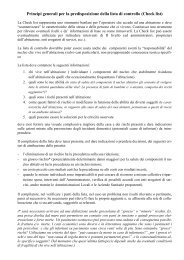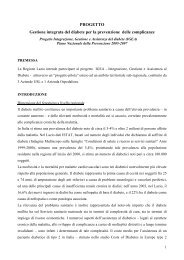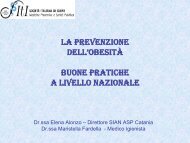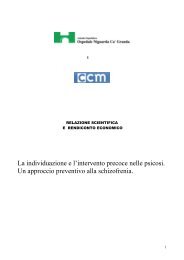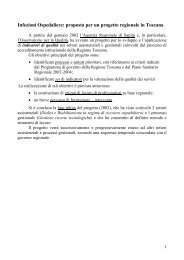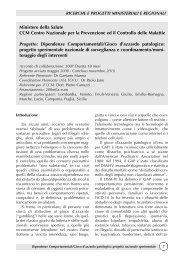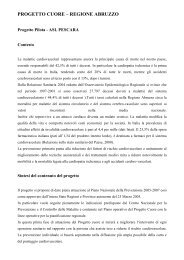Gaining health : analysis of policy development in European ...
Gaining health : analysis of policy development in European ...
Gaining health : analysis of policy development in European ...
Create successful ePaper yourself
Turn your PDF publications into a flip-book with our unique Google optimized e-Paper software.
as wide an understand<strong>in</strong>g as possible <strong>of</strong> the determ<strong>in</strong>ants<br />
<strong>of</strong> <strong>health</strong> and potential for <strong>in</strong>tersectoral action. The Conference<br />
recommended that comprehensive public <strong>health</strong><br />
reports be prepared regularly.<br />
2.1. Broad public <strong>health</strong> programme<br />
The Lithuanian Health Programme 1998–2010 (11) is the<br />
current “umbrella” <strong>policy</strong> for <strong>health</strong>. It is clearly based on<br />
the pr<strong>in</strong>ciple <strong>of</strong> equality <strong>in</strong> <strong>health</strong>, although at the time<br />
when it was written this was still understood ma<strong>in</strong>ly <strong>in</strong><br />
terms <strong>of</strong> equality <strong>in</strong> access to care. The programme covered<br />
the prerequisites for <strong>health</strong>, lifestyles conducive to<br />
<strong>health</strong>, appropriate <strong>health</strong> care, the environment, and the<br />
structures, tra<strong>in</strong><strong>in</strong>g and monitor<strong>in</strong>g system necessary for<br />
implementation and evaluation <strong>of</strong> outcomes. It was seen<br />
as a cont<strong>in</strong>uation <strong>of</strong> the National Health Concept and as a<br />
national adaptation <strong>of</strong> the WHO Health for All Policy.<br />
Its ma<strong>in</strong> objectives are:<br />
• a reduction <strong>in</strong> mortality rates and an <strong>in</strong>crease <strong>in</strong> average<br />
life expectancy;<br />
• equality <strong>in</strong> <strong>health</strong> and <strong>health</strong> care; and<br />
• improvement <strong>in</strong> the quality <strong>of</strong> life.<br />
Quantified targets were set to reduce, by 2010, mortality<br />
rates from accidents (30%), CVD and cancer <strong>in</strong> those under<br />
65 years <strong>of</strong> age (15%) and <strong>in</strong>fant mortality (30%), and<br />
to <strong>in</strong>crease life expectancy to 75 years. Explicit targets were<br />
set for reduc<strong>in</strong>g <strong>health</strong> risks such as smok<strong>in</strong>g and alcohol<br />
and fat consumption and for <strong>in</strong>creas<strong>in</strong>g physical activity.<br />
In relation to tackl<strong>in</strong>g <strong>in</strong>equalities <strong>in</strong> <strong>health</strong>, reference was<br />
also made to address<strong>in</strong>g the determ<strong>in</strong>ants <strong>of</strong> <strong>health</strong>, such as<br />
reduc<strong>in</strong>g <strong>in</strong>come differences, improv<strong>in</strong>g liv<strong>in</strong>g and work<strong>in</strong>g<br />
conditions, promot<strong>in</strong>g <strong>health</strong>y lifestyles (with specific attention<br />
to high-risk groups) and to improv<strong>in</strong>g access to <strong>health</strong><br />
care.<br />
2.1.1. How th<strong>in</strong>gs started<br />
At the time when Lithuania ga<strong>in</strong>ed its <strong>in</strong>dependence, there<br />
was already a firm evidence base and a critical core <strong>of</strong> highly<br />
skilled experts <strong>in</strong>tent on utiliz<strong>in</strong>g their skills to improve<br />
<strong>health</strong>. These experts provided clear leadership, notably the<br />
Rector <strong>of</strong> Kaunas University <strong>of</strong> Medic<strong>in</strong>e, Pr<strong>of</strong>essor Vilius<br />
Grabauskas, who was also President <strong>of</strong> the National Board<br />
<strong>of</strong> Health and team leader for the CINDI programme. They<br />
were widely respected and their guidance sought by politicians<br />
across political parties. With the evidence they provided,<br />
consensus was reached on the priority areas need<strong>in</strong>g<br />
urgent attention, which <strong>in</strong>cluded tackl<strong>in</strong>g CVD, cancer and<br />
diabetes and their related <strong>health</strong> risks. The overwhelm<strong>in</strong>g<br />
nature <strong>of</strong> the transition period, however, when every sector<br />
was br<strong>in</strong>g<strong>in</strong>g up urgent legislation, meant that <strong>health</strong> jo<strong>in</strong>ed<br />
a long wait<strong>in</strong>g list <strong>of</strong> issues com<strong>in</strong>g to Parliament.<br />
A Health Reform Management Group was established<br />
<strong>in</strong> 1993, provid<strong>in</strong>g leadership not only for <strong>health</strong> system<br />
reform but also for the <strong>development</strong> <strong>of</strong> policies for disease<br />
prevention and <strong>health</strong> promotion. The 1994 Lithuanian<br />
Health Law provided the necessary legislative background,<br />
and the follow<strong>in</strong>g year a task force was charged with prepar<strong>in</strong>g<br />
a situation <strong>analysis</strong> and action plan to address the<br />
major problems. To cont<strong>in</strong>ue the build<strong>in</strong>g <strong>of</strong> <strong>in</strong>tersectoral<br />
understand<strong>in</strong>g and support, the challenges outl<strong>in</strong>ed <strong>in</strong> the<br />
<strong>analysis</strong> were discussed <strong>in</strong> a full-day parliamentary session,<br />
broadcast on national radio, with four m<strong>in</strong>isters and a large<br />
number <strong>of</strong> members tak<strong>in</strong>g part.<br />
The ensu<strong>in</strong>g Lithuanian Health Programme was approved<br />
by the Collegium <strong>of</strong> the M<strong>in</strong>istry <strong>of</strong> Health <strong>in</strong> July 1996 and<br />
by the Government <strong>in</strong> October <strong>of</strong> that year. The follow<strong>in</strong>g<br />
spr<strong>in</strong>g, it received wide publicity when it was discussed at<br />
the Second National Conference on Health Policy. Experts<br />
from other countries and from WHO were asked to comment<br />
on the draft, which was reviewed by Parliament <strong>in</strong> July<br />
1998.<br />
Chapter 4<br />
193<br />
Case studies: <strong>policy</strong> <strong>development</strong> <strong>in</strong> countries for tackl<strong>in</strong>g noncommunicable diseases



